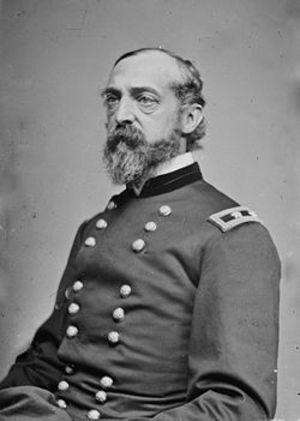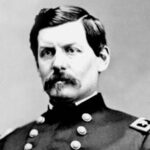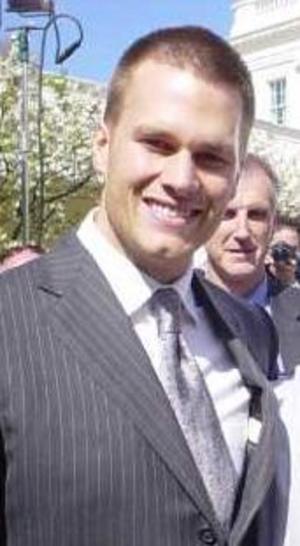Gen James Longstreet was the commander of the Confederate First Corps of the Army of Northern Virginia and was considered the second in command to Gen Robert E. Lee during the battle of Gettysburg. Who was James Longstreet and what impact did he have on the outcome of the battle? These are the questions that I will try to address in this article.
James Longstreet was born in Edgefield District, South Carolina on January 8, 1821, to James and Mary Ann Dent Longstreet, James was the fifth child and third son born to them. They were of Dutch extraction, his ancestor Dirck Stoffels Langestraet had immigrated to the Dutch colony of New Netherland in 1657. The name Langestraet became Anglicized over the generations to Longstreet.[1]
His father wanted a military career for him but felt that his education would better be served in Augusta, Georgia, so at the age of nine, James was sent to live with his aunt and uncle. He spent the next eight years on his uncle’s plantation, during that time he attended the Richmond County Academy.
In 1838 he was appointed to the United States Military Academy where he graduated in 1842, 54th out of 56 cadets. After graduation, Longstreet was commissioned a brevet second lieutenant in the 4th U.S. Infantry. When the Civil War began, he joined the Confederate Army and since he was the ranking officer from Alabama he was made a brigadier general. He immediately drilled his brigade three times a day, he also instilled discipline in his troops and two weeks later the brigade was involved in the battle of First Manassas.
At the battle of Seven Pines, his performance was poor where he either misunderstood his orders from Gen Johnston or changed them. He was ordered to advance on the Nine Mile Rd, but he joined Gen Hill’s column on the Williamsburg Road which limited the ability of the attack to be successful. Gen Longstreet at the Seven Days’ battle gave a solid performance and he was awarded by being promoted to Lt General and given command of the 1st Corps.
The battle of Second Manassas he was slow in getting into position but then performed wonderfully and at Antietam did an outstanding job in holding his lines during the most critical hours of the battle. His best performance was at the battle of Fredericksburg where he had his defensive line set up to repulse wave after wave of Federal attacks.
The battle of Gettysburg, July 1st, 2nd, 3rd of July 1863 was in the opinion of this writer Longstreet’s poorest performance of any battle he fought during the Civil War. At the beginning he wanted to fight a defensive battle (possibly remembering the Battle of Fredericksburg) and urged Gen Lee to move to the right to a position between the Army of the Potomac and Washington where Gen Lee would fight a defensive battle. Gen Lee disagreed with him so he dropped the subject for the time being.
Gen Lee gave the orders to Longstreet to attack the Union’s left flank, while Gen Hill attack the Union’s center on Cemetery Ridge and Gen Ewell would make a demonstration on the Union’s right. Lee wanted this attack to take place early in the day, but Longstreet stalled, receiving permission to wait until Gen Law’s Brigade of Gen Hood’s division arrived. It wasn’t until around noon that he arrived and Longstreet finally began to move.
Longstreet’s orders were to move without being seen by the enemy, so he had to march a long detour to get to the attack position. Due to poor reconnaissance Longstreet had to countermarch the column due to the fact that they could be seen by Union troops if they continued on as they were heading. After a frustrating march of three miles and four hours later they finally arrived in Pitzer’s Woods opposite the Peach Orchard. Discovering that the Union troops had moved up to the Peach Orchard, another delay occurred while Hood’s Division deployed to McLaws’s right so as to uncover the Union’s flank.
From about 4:00 to 4:30 Gen Hood tried to convince Gen Longstreet to go around the Union’s left rather than attacking straight on, but each time Longstreet refused, saying that Gen Lee ordered the attack and it cannot be changed. Finally around 4:30 Hood’s division moved to the attack. The fighting continued until darkness ended the battle and Gen Longstreet said about the fighting “the best three hours of fighting every done by any troops on any battlefield”.
Gen Lee sent orders to Longstreet to renew the attack early the next morning using Pickett’s Division. The attack was to be against the Union’s center, with Pickett’s Division and some of A P Hill’s brigades. Right at the start Longstreet was against the attack and when Gen Lee rode over to his headquarters the next morning, he found that Longstreet had not even began to get ready for the ordered attack.
So Gen Lee’s original plans had to be revised and after examining the Union line, Lee pointed to a clump of trees and designated it as the point of attack. Again Longstreet objected, saying “the fifteen thousand men who could make successful assault over that field had never been arrayed for battle”[2] Finally he personally directed Pickett’s men into their positions, included in the assault would be some of Heth’s, Pender’s and Anderson’s divisions.
After about two hours, some historians say less, of artillery bombardment, the infantry was ready to move forward. Longstreet still could not give the order to advance when asked by Gen Pickett, he just nodded, and the attack began.
Gen Longstreet’s conduct at Gettysburg has been a source of heated controversy since the battle ended July 3rd 1863. Gen Lee considered Longstreet his “Old War Horse” and valued his judgment and opinions, but he let him down at Gettysburg, due to his not agreeing with the battle plans. He was a pouter and at times showed balkiness if he did not agree with his orders. Throughout his Civil War experiences he at times blamed others for his failures.
During battle he showed no fear and was cool under fire. He cared about his men and took care of them as best he could. His aide Moxley Sorrel described him as “A most striking figure…a soldier every inch, and very handsome, tall and well proportioned, strong and active, a superb horseman and with an unsurpassed soldierly bearing, his features and expression fairly matched; eyes, glint steel blue, deep and piercing; a full brown beard, head well shaped and poised. The worst feature was the mouth, rather coarse; it was partly hidden, however, by his ample beard.”[3]
One thing that may have led to his personality and tendencies was the death of his three children in 1862 from scarlet fever. Before their deaths, he was the center of socialization, at his headquarters; a visitor could expect a fine meal, whiskey and a game of poker, after the death of his children he changed. No more porker parties, he rarely drank and became a devout Episcopalian. He became more withdrawn often saying little beyond a gruff “yes” or “no”.
As Jeffrey D. Wert stated in the Introduction To The DA Capo Edition of From Manassas to Appomattox by Gen James Longstreet we see how complex a man Longstreet was “Longstreet was assuredly a flawed man and a flawed general. His self-confidence led him to overestimate his own abilities and to dismiss his own mistakes while blaming others for them. His conduct in certain battles and campaigns deserve censure. He failed at Seven Pines in May 1862 and in East Tennessee in the fall of 1863. his performance at Gettysburg on July 2 requires penetrating analysis. But during the Seven Days, at Second Manassas, at Sharpsburg, at Fredericksburg, and at the Wilderness, Lee had no finer officer in the army. Lee knew that, and so did the men who served under Longstreet”.
As to Longstreet’s performance at Gettysburg, Moxley Sorrel, his aide stated “There was apparent apathy in his movements. They lacked the fire and point of his usual bearing on the battlefield”[4] Gen Lafayette McLaws wrote “during the engagement he was very excited giving contradictory orders to everyone, and was exceedingly overbearing. I consider him a humbug-a man of small capacity, very obstinate, not at all achivalrous, exceedingly conceited, and totally selfish”[5] He could not execute Lee’s orders with the required celerity when they ran counter to his idea of the right way to fight a battle.
In conclusion, General James Longstreet now belongs to the ages, and how you interpret the history will depend if he was a factor in the Confederate’s defeat at Gettysburg. There were many “what ifs” of the battle and many who rose to the occasion and some who failed to live up to expectations was General James Longstreet one of these?
[1] en.wikipedia.org
[2] From Manassas To Appomattox by Gen James Longstreet
[3] www.rocemabra.com
[4] www.rocemabra.com
[5] www.rocemabra.com





